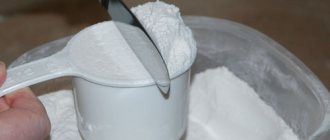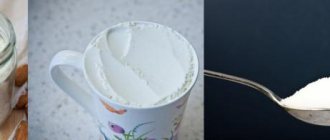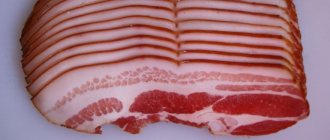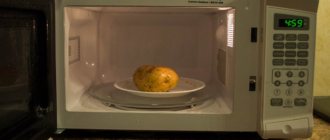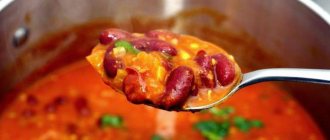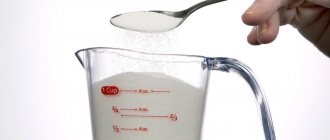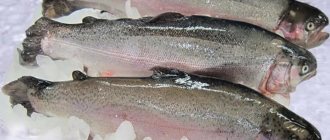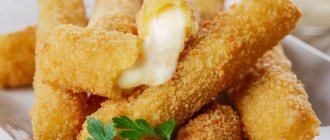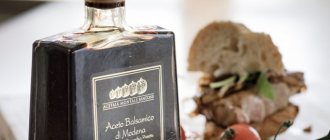Weight table
You can find such a hint in a cookbook or use the one given in the article. It is very convenient to use the table, since it records the weight of products in grams when filling any dishes. For example, one teaspoon holds 5-7 grams of sugar, a tablespoon holds 25, and a regular faceted glass holds 200 grams if you fill it to the very top.
Measurement table for fruits, berries, vegetables (content in grams)
| The product's name | Glass /250 ml/ (faceted glass to the brim) | Tablespoon | Tea spoon | 1 PC. |
| Potato | — | — | — | 80-85 |
| Carrot | — | — | — | 65-75 |
| Red beetroot | — | — | — | 250-280 |
| Eggplant | — | — | — | 230-250 |
| Apricot | — | — | — | 26 |
| Banana | — | — | — | 85-100 |
| Pomegranate | — | — | — | 125 |
| Pear | — | — | — | 135 |
| Ginger | — | — | — | 40 |
| Peach | — | — | — | 85 |
| Plum | — | — | — | 30 |
| Persimmon | — | — | — | 85 |
| Apple | — | — | — | 100-120 |
| Dried apples | 70 | — | — | |
| Orange | — | — | — | 130-150 |
| Grapefruit | — | — | — | 275-300 |
| Lemon | — | — | — | 60-75 |
| Cherry | 165-190 | 30 | — | — |
| Cherries | 165-190 | 30 | — | — |
| Cowberry | 140 | 50 | — | — |
| Blueberry | 260 | — | — | — |
| Blackberry | 190 | — | — | — |
| Cranberry | 145 | — | — | — |
| Gooseberry | 210 | — | — | — |
| Raspberries | 160-180 | 20 | — | — |
| Strawberry | 150 | 25 | — | — |
| Currant | 175 | 20 | — | — |
| Black currant | 180 | 30 | — | — |
| Dried plums | 250 | 25 | — | — |
| Rose hip | — | 20 | 6 | — |
| Peanut | 175 | 25 | 8 | — |
| Hazelnut | 160 | 30 | 10 | — |
| Peas | 230 | 25 | 8 | — |
| Lentils | 210 | 24 | 7 | — |
| Pine nuts | 140 | 10 | 4 | — |
| Sunflower seeds | 170 | 25 | 8 | — |
| Pumpkin seeds | 100 | 15 | 8 | — |
| Blueberries (dried) | 130 | 15 | — | — |
| Blueberry | 200 | 35 | — | — |
| Strawberry (1 berry) | — | — | — | 8 |
| Bulb onions | — | — | — | 75-80 |
| Cucumber (medium) | — | — | — | 100 |
| Parsley root | — | — | — | 150 |
| Tomato | — | — | — | 75 |
| Radish | — | — | — | 20 |
| Radish | — | — | — | 170 |
| Turnip | — | — | — | 85 |
It is interesting to know : that the most popular questions are “how many grams of sugar are in a glass”, “how many grams of flour are in a glass”, “how many grams are in a glass of walnuts”, “how many grams are in a glass of pine nuts”.
Source
Frozen with hand
There is a good folk method that will help solve the problem of how to measure grams without scales. This method will be convenient for those who do not want to exhaust themselves with mathematical calculations. The disadvantage of the method is only an approximate result.
- If you need to measure a piece of fish or meat of 100 grams, then look at the woman’s palm - both the size and thickness will correspond to 100 grams. If we take a man’s hand as an example, then we add 50 grams.
- If you need to measure a portion of cereal, then 200 grams will be equal to the size of a woman’s fist and approximately 250-280 to the size of a man’s.
Accuracy - the politeness of kings
To measure the weight of products without scales, you need to follow some rules that will help you strictly follow the recipe. For preparing appetizers, soups, main courses and side dishes, this is not so critical. However, in some cases, such as when baking bread, an incorrect ratio of liquid to flour can cause fermentation to slow down. If there is a lack of moisture, the dough does not rise well and the bread has a dry, crumbly texture. If, on the contrary, there is too much moisture, the baked goods will turn out heavy, mushy, with a soggy and sticky crumb.
Dishes capacity
At a hardware store you can purchase special containers made of transparent plastic or glass, on the walls of which the weight measures in grams of liquid and bulk products will be written.
If you don’t have such utensils, just use any cup whose volume you know for sure. For example, you have a bowl with a volume of 100 grams, and you need to measure 50 grams. Then just fill this bowl halfway and get the required amount of product.
Methods of measuring with improvised means
How to measure 5 ml of any liquid?! To do this, we look at the tables above (depending on the type of liquid) and try to measure either with drops or with a spoon.
For example, for water, iodine and peroxide 5 ml you need to take 1 teaspoon or one hundred drops.
Scales
If you don’t have a spoon or pipette at home, you can use a simple kitchen scale. These scales support the function of measuring the volume of a solution in ml. If they do not support measurements in ml, then you can measure in grams.
Watch the video, where the grams and ml of products are immediately indicated for a specific recipe:
In the video, substances are measured using a faceted glass.
1 faceted glass is equal to 200 ml up to the edges, or 250 ml to the brim. Water and milk equal 200 grams to risk, vegetable oil 190 grams.
Measuring cup, saucepan
In the kitchen you can find a measuring cup. It has gradations in ml and grams. Using the above tables, you can easily determine how many ml are in 1 drop. Some pots have ml indicators; at least “by eye”, you can determine the volume of water.
Finger
Dip your finger in the medicine and liquid will begin to fall from it, all you have to do is count out your 20 drops. This method is suitable if you only need to measure out a small number of drops, otherwise you will lose more product than you measure out.
Syringe
We take a syringe, preferably insulin. Its volume is equal to one ml, the decimal parts are clearly marked on such a syringe, so it will not be difficult for you to measure out 50 drops of valerian. You just need to fill the insulin syringe 2.5 times and pour the solution into some container, or use a syringe with a different volume, 2 or 5 cubic meters. In this case, we use the reverse method. We look not at how many milliliters are in 1 drop, but how many drops are in one milliliter.
Pipette, dispenser for other medications
You have already looked at the pharmacy, but did not find a syringe there. Then take a closer look at medications with dispensers. You can simply remove the cap from one and put it on the jar you need. Just remember to rinse the dispenser thoroughly before doing this so that there are no residues of other medications.
Cough syrups usually come with spoons or small glasses; with their help you can also measure the required amount of ml.
Handy items
Drink straw
You can draw the medicine into a tube, cover the bottom with your finger and then slowly release it. Control the process so that the liquid does not simply pour out of the tube, but drips.
Regular wooden stick
It could be just a wooden stick, an ice cream stick, wet it, lower it down and wait for the drops to fall.
Cotton swab
Dampen a cotton swab; liquid will start to drip from it.
Spoon
Pour the syrup into a spoon and slowly lower it until it starts dripping.
Plastic fork, spoon
Such items usually have a tunnel on the back, i.e. there is a hollow space into which you can pour liquid and lower it again, and wait for the drops.
Rags
Extreme way. If you have a large volume of liquid, which you don’t mind. Dampen a rag, squeeze out excess water and wait until the drops begin to fall.
Checked notebook sheet
Dishes and hands are, of course, good, but what if you need to measure, for example, manganese? Taking powder “by eye” is completely unacceptable, and then a reasonable question arises: “How to measure 1 gram without a scale?”
We suggest using the old method; it has already helped out a huge number of housewives.
- Pour the powder into a level teaspoon, it will be 5 grams.
- Pour the powder onto a notebook sheet into a square, distribute it across the squares in an even strip so that it covers 10 squares.
- Two cells will be a gram.
If the jar of powder has not yet been opened, then you can use a simpler method - look at the net weight on the package. If it says 10 grams, then pour it onto the sheet so that the strip takes up 20 cells, and 2 of them will equal 1 gram.
How to measure yeast in grams without a scale? Use the same method. If you need to take 5 grams of this product, then feel free to take 1 level teaspoon.
This method does not work for measuring flour, since it is denser and will weigh more. We suggest considering options on how to measure flour in grams without scales.
How to determine the weight of a product without a kitchen scale?
Do you have a kitchen scale? I don't have one. Do you think I'm suffering? Well. maybe just a little.
How to determine the weight of a product, especially if it is vegetables?
1️⃣ Use the services of a supermarket
I usually buy vegetables in supermarkets, where I either weigh them myself or the seller does it valiantly.
Save the receipt, it usually indicates the weight of the product. It’s even easier if the product has a barcode sticker with the exact weight of the product. I simply divide this weight mentally into so many parts so that in the end one of them is equal to the weight that I need and cut/divide the product.
2️⃣ What to do if the ingredient is bulk? It’s even easier here - a measuring cup!
I bought it in Auchan, if my memory serves me right, for 17 rubles. And honestly, this is one of the best inventions for housewives. Mine has four scales: water, flour, salt, sugar. This is quite enough to adequately measure the weight. One minus of my cup is that it is made of plastic and cracked from hot water. But, in this case, if it suddenly falls apart, I’ll just buy the same new one
